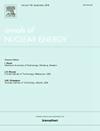Numerical study on a wire-wrapped fuel rod vibration induced by axial Pb-Bi coolant flow
IF 1.9
3区 工程技术
Q1 NUCLEAR SCIENCE & TECHNOLOGY
引用次数: 0
Abstract
In this paper, the CFD analysis on the Pb-Bi axial flow around a wire-wrapped rod were performed and the vibrations of a wire-wrapped rod caused by the Pb-Bi axial flow were numerically studied. The effects of the pitches, flow rates and constraints on the vibration displacements and frequency were discussed. It was found that the transverse flow intensity increased twofold when the wire pitch was reduced from 400 mm to 200 mm. The augmentation of inlet flow rate from 1 m/s to 2 m/s resulted in an approximately fourfold amplification of the turbulent kinetic energy. The shear stress and pressure on the rod surface fluctuated significantly at the wire location. The force due to the wall shear stress was at least two orders of magnitude smaller than the pressure component. The vibration pattern of the fuel rod was consistent with the first-order vibration pattern and the main vibration frequency was close to the first-order natural frequency. The RMS of the fuel rod amplitude increased from 13.71 μm to 19.60 μm when the wire pitch decreased from 400 mm to 200 mm. When the inlet velocity increased from 1 m/s to 2 m/s, the RMS of the amplitude increased from 4.98 μm to 19.6 μm. When the both ends were restrained by completely fixed support, the vibration displacement at the center point decreased by 46 % compared to that in the case with circumferentially fixed in the upper end and completely fixed in the lower end. This study can provide the theoretical guide to the design of wire-wrapped fuel rods in the lead–bismuth cooled fast reactors.
铅铋冷却剂轴向流动诱导线包燃料棒振动的数值研究
本文对绕丝杆Pb-Bi轴向流动进行了CFD分析,并对绕丝杆Pb-Bi轴向流动引起的绕丝杆振动进行了数值研究。讨论了螺距、流量和约束条件对振动位移和频率的影响。当丝距从400 mm减小到200 mm时,横向流动强度增加了2倍。当入口流速从1m /s增加到2m /s时,湍流动能增加了约4倍。棒材表面的剪应力和压力在线材位置波动较大。壁面剪应力产生的力比压力分量至少小两个数量级。燃料棒的振动模式符合一阶振动模式,主振动频率接近一阶固有频率。当丝距从400 mm减小到200 mm时,燃料棒振幅的均方根值从13.71 μm增大到19.60 μm。当进口速度从1 m/s增加到2 m/s时,振幅的均方根值从4.98 μm增加到19.6 μm。与上端周向固定、下端完全固定时相比,两端完全固定支承约束时,中心点振动位移减小46%。该研究可为铅铋冷快堆包线燃料棒的设计提供理论指导。
本文章由计算机程序翻译,如有差异,请以英文原文为准。
求助全文
约1分钟内获得全文
求助全文
来源期刊

Annals of Nuclear Energy
工程技术-核科学技术
CiteScore
4.30
自引率
21.10%
发文量
632
审稿时长
7.3 months
期刊介绍:
Annals of Nuclear Energy provides an international medium for the communication of original research, ideas and developments in all areas of the field of nuclear energy science and technology. Its scope embraces nuclear fuel reserves, fuel cycles and cost, materials, processing, system and component technology (fission only), design and optimization, direct conversion of nuclear energy sources, environmental control, reactor physics, heat transfer and fluid dynamics, structural analysis, fuel management, future developments, nuclear fuel and safety, nuclear aerosol, neutron physics, computer technology (both software and hardware), risk assessment, radioactive waste disposal and reactor thermal hydraulics. Papers submitted to Annals need to demonstrate a clear link to nuclear power generation/nuclear engineering. Papers which deal with pure nuclear physics, pure health physics, imaging, or attenuation and shielding properties of concretes and various geological materials are not within the scope of the journal. Also, papers that deal with policy or economics are not within the scope of the journal.
 求助内容:
求助内容: 应助结果提醒方式:
应助结果提醒方式:


